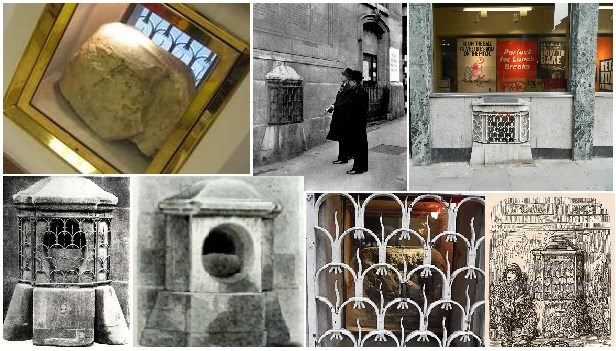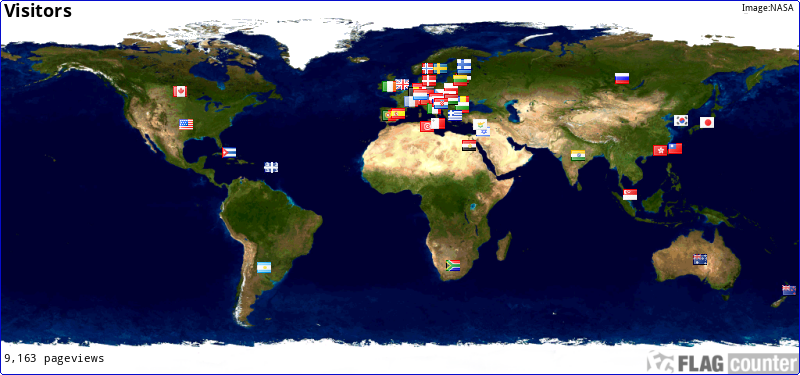London Stone
No one would blame the tourists who walk right past the London Stone. Measuring less than two feet on its longest side and encased behind a white iron grate on Cannon Street, it's one of the most unassuming attractions in London. However, this rock is much more than a rock.
(More information further down. BUT first the earth lesson.)

Limestones
Lets see and learn something about Limestones:
Limestone is a sedimentary rock comprising at least 80% calcium carbonate (CaCO3). Limestones can be deposited in both marine and fresh water environments, the former being more common, and can take many forms such as those described below.
CHALK
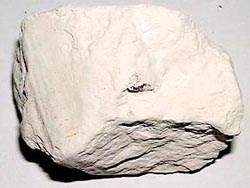
Chalk is a pure, soft, well-jointed limestone composed primarily of the calcareous remains of micro-organisms called coccoliths and foraminifera. Although we provide a close-up of this rock there is nothing more to see than in the larger image, its only to be seen by a scanning electron microscope.
Pure white chalk contains more than 90% CaCO3 and is usually found in thick beds. In Britain it stretches from Yorkshire down to the famous cliffs of Dover. These where deposited in the Cretaceous (~100 million years ago) when Britain was submerged under a deep sea. The Haptophyte organisms that produce the coccolith skeletons that become chalk are pelagic organisms living in the surface waters of the world's oceans. The skeletons eventually settle to the bottom and accumulate to become chalk - if conditions are favorable. Coccolith skeletons are settling most everywhere out of today's oceans, and should be accumulating everywhere in the oceans. But, if the water is too deep it becomes too cold, and the skeletons dissolve. Therefore, chalk accumulates only at shallower depths, and today that is along the oceanic rift systems.
We might also expect chalk to accumulate in shallow waters next to continents, such as on the continental shelves, but here there is too much clastic sediment, and whatever skeletons get to the bottom are typically lost in the clays, silts, and sands.
Colour: white, grey or yellow.
Mineralogy: mainly calcite
Occurrence: chalks are pelagic limestones formed in shallow, open seas.
Texture: fine grained and finely porous.
Structure: usually well bedded in thick extensive successions, nodules of flint and marcasite are common
SHELLY LIMESTONE
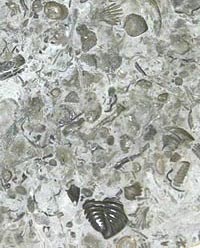
Fossiliferous limestones but technically it is called a packed biosparite. Packed because it is packed full of skeletons, bio=fossils, sparite=calcite cement between the skeletons, some whole some fragmented, cemented by a spar matrix (crystalline calcite). Most of the fossils are crinoid stem fragments, but favositid (honeycomb) corals and stromatoporoids are also common. This is also a corase, poorly sorted rock, with skeletons of many different sizes jumbled together. A number of scours, erosion surfaces, are also visible indicating periods of very strong currents, most likely storms.
Carboniferous limestone is an example of a shelly limestone and is found predominantly in the Peak District and Yorkshire Dales where it forms a distinctive landscape known as karst. The limestone was deposited in the Carboniferous period, over 300 million years ago, and tells us that Britain once lay in warmer latitudes. This tropical environment was similar to the Caribbean of today with lots of algae, corals, and brachiopods. Before this became a rock we can imagine it as a rubble pile of skeletons lying on the bottom with no other sediment intermixed with them.
Colour: variable.
Mineralogy: finely divided calcite mud containing larger crystals from animal skeletons.
Composition: calcareous.
Occurrence: widely distributed.
Texture: variable.
Structure: bedding often apparent, the fossils may be complete or fragments.
OOLITIC LIMESTONE
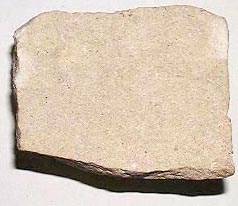
Oolitic limestone is a carbonate rock made up mostly of ooliths (or ooids) which are sand-sized carbonate particles that have concentric rings of CaCO3. These rings are formed around grains of sand or shell fragments that were rolled around on the shallow sea floor, gathering layer after layer of limestone. The mechanism of formation is to begin with a seed of some sort, perhaps a shell fragment. The strong currents wash this seed around on the bottom where it accumulates a layer of chemically precipitated calcite from the supersaturated water. Only this process is going on with uncounted trillions of oolites. The oolites are commonly found in large dunes (megaripples); if you could be there you could scoop up the oolites in your arms and hands. The concentric layers is formed as the oolites are alternately exposed to pick up a concentric layer, and then buried to set the layer. The next exposure then adds another layer.
Portland limestone is an example of an oolitic limestone. This limestone formed in a shallow sea, rather like the modern Bahamas, near the end of the Jurassic period (~135 million years ago). The rock has an even structure rather like cod roe and it can therefore be cut or sculpted in any direction. This feature, coupled with hardness, colour and durability, gives the limestone its quality as a building stone.
Colour: white, grey or yellow.
Mineralogy: mainly calcite
Occurrence: chalks are pelagic limestones formed in shallow, open seas.
Texture: fine grained and finely porous.
Structure: usually well bedded in thick extensive successions, nodules of flint and marcasite are common
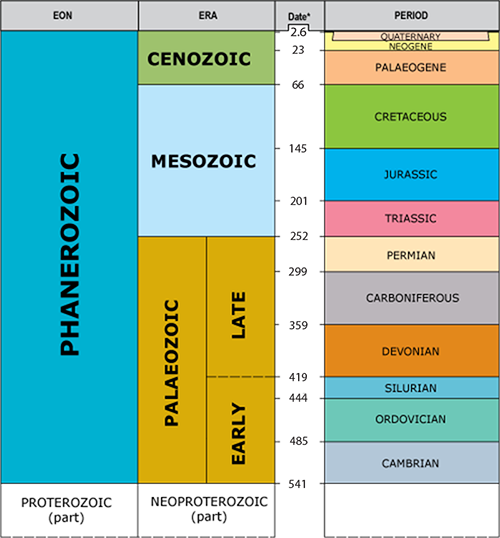
To log this cache.
To get to log this cache you will have to visit and answer the questions which are related to the coordinates given the earthcache.
When answers are collected, send them to CO for verification.
As I own about 50 earthcaches there are MANY mails/messages to answer back on, and I will not always be able to answer right-back, BUT I READ ALL SENT ANSWERS AND LOGS, so if anything is not correct or need an upgrade, you will indeed hear back from me.
Thanks for your understanding, and for picking one of my caches.
You can log immediately answers are sent CO. If there are any questions about your answers CO will contact you.
Logs without answers to CO or with pending questions from CO will be deleted without any further notice.
Please do not include pictures in your log that may answer the questions.
Questions
1. Answer the questions under by visiting the Coordinates.
A. The earthcache theme is Limestone, and above its been described three different types: (CHALK/SHELLY LIMESTONE/OOLITIC LIMESTONE). By visiting gz tell me what type of limestone that is at display, and why do you think your choice is correct!
B. Describe the surface and the texture of the stone, what color is it, and why is the color (light/medium colored/dark). And can you say anything about its origin?
C. Why do the stone have pitted holes in its surface?
D. How many % calcium carbonate would you say is comprising in a sedimentary Limestone?
E. What period of time does the displayed Limestone come from? (Use the diagram above from the cache text, and pick your answer from the right hand side, saying: Period.)
2. Take a photo of yourself, the group or your GPS when logging the cache.
Without revealing any answers!
(It’s voluntary to post a photo in your online log)
London Stone
London Stone is a historic landmark at 111 Cannon Street in the City of London.
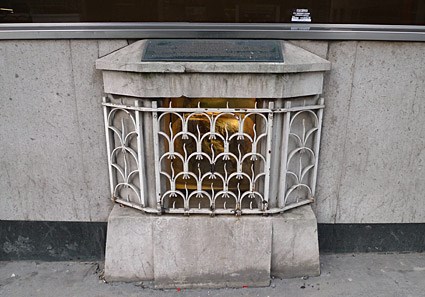
Was located at the Musem of London, displayed at the War plague and fire galley, next one after the medieval gallery section for approx 20months ++ time. (13.05-2016 / 25.09.2018)
The present London Stone is only the upper portion of a once much larger object. The surviving portion is a block of ***** limestone approximately 53 cm wide, 43 cm high, and 30 cm front to back (21 × 17 × 12 inches). A study in the 1960s indicated that the stone is Clipsham Limestone, a good-quality stone from Rutland transported to London for building purposes in both the Roman and medieval periods. More recently Kevin Hayward has suggested that it may be Bath stone, the stone most used for monuments and sculpture in early Roman London and in Saxon times.
The name "London Stone" was first recorded around the year 1100. The date and original purpose of the Stone are unknown, although it is possibly of Roman origin, and there has been interest and speculation about it since at least the 16th century. There are modern claims that it was formerly an object of veneration, or has some occult significance. These assertions however, are completely unsubstantiated
Since 1962 London Stone has been located on the north side of Cannon Street, opposite Cannon Street station, housed in an aperture in the wall of number 111 Cannon Street (London EC4N 5AR), surrounded by a decorative Portland Limestone stone fascia with an iron grille. Inside the building it is protected by a glass case. The stone and its surround, with the iron grille, were designated a Grade II* listed structure on 5 June 1972.
A bronze plaque on the sloping top of the casing, dating from 1962.
From Memory plate:
This is a fragment of the original piece of limestone once securely fixed in the ground now fronting Cannon Street Station.
Removed in 1742 to the north side of the street, in 1798 it was built into the south wall of the Churrch of St.Swithun London Stone witch stood here until demolished in 1962.
Its origin and purpose are unknown but in 1188 there was a reference to Henry, son of Eylwin de Londenstane, subsequently Lord Mayor of London.
6 Myths of the London Stone
1. IT’S THE PLACE THAT ALL ROADS LEAD FROM.
2. IT HAS THE POWER TO NAME THE LORD OF THE CITY.
3. AND THE POWER TO NAME THE RIGHTFUL KING
4. IT WAS WORSHIPED BY THE DRUIDS.
5. IT HAS MAGICAL POWERS.
6. IT IS ESSENTIAL TO THE SURVIVAL OF LONDON ITSELF.
